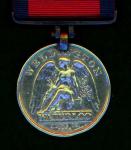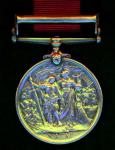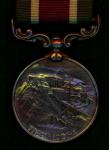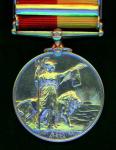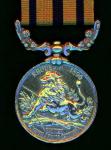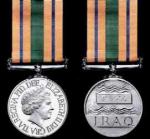-
Posts
235 -
Joined
-
Last visited
-
Days Won
1
Content Type
Profiles
Forums
Blogs
Gallery
Events
Store
Everything posted by Tony Farrell
-
Service requirement for medallic recognition is a very complex subject. There is no logical pattern. The eligibility criteria for certain awards have been amended on more than one occasion, both increasing and reducing the time served to become eligible for a medal, as have certain issues become defunct due to the re-arrangement of certain elements within the forces. Also, the word 'forces' is a broad brush. There has never been a generic twelve year award - regular and reserve elements of the three services each having their own awards with differing entitlement periods - some 'metric' and some 'imperial', i.e. 10 v 12. Playing off a Police LSM against a Royal Navy LSM's varying terms and conditions is pointless, as the appropriate issuing authorities determine who gets what and when. Niether is the police medal 'the same medal' as those awarded elsewhere.
-
I have been working on a book (provisionally titled For Long & Efficient Service) for the past few years. It will hopefully see the light of day in the coming months. As the title suggests, it concentrates on LSMs, though several meritorious issues are also included. With well over one hundred colour plates covering over eighty issues, all long service awards are covered - both British and Imperial, though the nationalised and provincial awards of Australia and Canada are omitted.
-

My Medals
Tony Farrell replied to Tiger-pie's topic in Great Britain: Orders, Gallantry, Campaign Medals
Johnsy, as 'pitiful shoite' as the ADM may seem to some, it's at least 'something' - and significantly more than I ever - or am likely ever - to receive from the British government. All I have to show is a pair of battered kindneys and a shattered liver - and rampant hair loss. -
By default of their postings, the 18th pretty much missed out on most of the actions during this rather turbulent period, due to them being stuck out in the West Indies, so this could well be his only 'entitlement' - albeit self-awarded, and assuming that he was indeed in the Royal Irish and not some obscure artillery battery.
-
Any chance of posting some images of the naming details? Whist it was (and still is) not uncommon for a recipient to be awarded his medal after discharge, this date I find totally wrong - assuming 'DIS' indicates a discharge date. I can see no point in an attestation date on a medal - and this would not be in keeping with contemporary LS awards. Something is telling me that this is a self-replaced medal. It would be possible for a man discharged in 1816 to find another (post 1837) medal much later on in life and have it named up with his details. Early Victorian medals used impressed, broad, upright serif capitals - the same as that used on the Waterloo medals of 1815. The date of the award was also impressed. Later Victorian issues (from 1850 onwards) were both officially impressed in upright capitals and engraved in a variety of regimental styles - both with and without the award date, and in varying degrees of uniformity. Of course, this means nothing if he'd done it himself. It was also common for foot regiments to be referred to (by those in them) as battalions - as they were (usually) battalion-sized. 18th Battalion may well refer to the 18th Foot. I'm sure if he was a gunner then the medal would be inscribed either RA or Arty etc.
-

Virtual Medals?
Tony Farrell replied to Lukasz Gaszewski's topic in Great Britain: Orders, Gallantry, Campaign Medals
The Northern Ireland Home Service Medal replaced the UDR Medal following the amalgamation of the Ulster Defence Regiment with the Royal Irish Rangers to form the Royal Irish Regiment - the former UDR battalions forming the Home Service component of the new regiment. The medal was for the part-time personnel of the regiment for twelve years' service, full-time staff receiving the Military LS&GC Regular Army for fifteen. The criteria for award are the same as the old UDR Medal. The HS battalions have now been disbanded and the medal is defunct. -
Well, it's a good job we did plunder a few treasures, otherwise there'd be bugger all left to take medal designs from, seen as the Baghdad Museum is now (sadly) pretty much sans exhibits -courtesy of the local populace (and I was so tempted to say 'natives' then). The first thing the ribbon reminded me of was the Africa Star. All in all I quite like it, and I can see these being quite hard to find - unlike the Iraq Medals... and unlike the copies which will undoubtedly appear on eBay within a fortnight... if that! [I was wondering how long it'd take for my dodgy, patched together, photo-editing efforts to appear elsewhere]
-

Colonial Auxiliary LS and GC
Tony Farrell replied to Mossy's topic in Great Britain: Orders, Gallantry, Campaign Medals
A nice find. Could you describe the naming style, e.g. engraved, impressed, upright, sloping, serifed? -
Ed's bang on the money. These were produced several (early '80s I think) years ago for the purpose of providing 'collectors' with a 'collection' - not unlike the mass-produced 'limited edition' junk that's pedalled in the Sunday supplements. These are more akin to football coins - the sort that petrol stations used to give away in the 1970s, and were meant to be displayed accordingly, i.e. in one of those cut out insert boards.
-

GC and Silver Jubilee medal
Tony Farrell replied to a topic in Great Britain: Orders, Gallantry, Campaign Medals
You've got it! -
So why is this one different? Really, this is in danger of becoming a single unattributable item/s. I am rather baffled as to why it's not with the rest of his entitlement?


